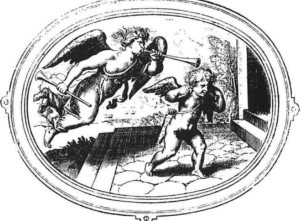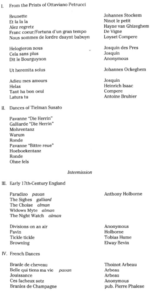Program: #94-02 Air Date: Jan 10, 1994
We are experiencing difficulties with our usual, more featureful audio player. We expect to fix this soon; until then, please enjoy the music with this 'classic' audio player.
Founded in 1977 by Robert Eisenstein, Christopher Kendall, and Scott Reiss, the Folger Consort is ensemble-in-residence at the Folger Shakespeare Library. With over thirty performances each season, including appearances on major series in cities across the country, the Consort has created one of the most successful early music series in the country. The ensemble's performances are broadcast locally on WETA-FM, and nationally over National Public Radio and American Public Radio.
This program is Free for all, thanks to this generous Preservation Grant:

The Folger Consort - Festival of Winds
When our two ensembles first decided on this collaborative program, our problem was one of limiting the repertory we would present. Our combined forces of loud and soft winds together with strings make possible performances of most of the instrumental music of the Renaissance. In thinking about the possibilities, we soon realized that we were mostly looking forward to music printed in the 16th century, as opposed to manuscript sources. On reflection, this does not seem entirely coincidental. The rise of written instrumental music (as opposed to the unpreserved aural tradition) corresponds to the widespread availability of printed music for players to use. None of this music was ever intended for the concert hall. Some of it, particularly the late 15th-century repertory preserved in Petrucci's prints, could have been played at northern Italian courts by the resident bands of pifari, or wind players, for the enjoyment of noble households. Outside of these pieces, none of the music presented here was strictly meant to be listened to at all. Most of it, including the arrangements by Susato, Arbeau, and Phalese, is intended for practical use to accompany dancing. The one unifying element in all this music is that it was printed for the use and enjoyment of players and dancers, and not for an outside audience in the modern sense. For all that, there are many wonderful little pieces here, from the miniature masterpieces of Josquin, Compere, and Isaac to the skillful arrangements of popular tunes in Susato's dance book. They are quite entertaining to listen to, and remind us of a time when music-making was not so much a consumer item to be purchased in various formats such as a concert ticket or compact disc, but an activity to participate in and share with friends.
I. The invention of music printing from movable type must certainly be regarded as one of the great innovations in music history. Prior to the development of this technique, composers had to rely on their own performances, and they laboriously copied manuscripts for the dissemination of their works. The printed music book changed all that, opening up a vast market for composers and in effect creating for the first time a "public" audience for new music beyond the elite circles at court and chapel who had access to rare manuscripts.
While there were experiments in music printing in the 15th century (mostly of Gregorian chant), it was left to the Venetian Ottaviano Petrucci (1466-1539) to perfect a method for printing part-music. He applied to the Venetian government in 1498 for the exclusive right to print "canto figurato," because he had perfected a method of doing "what many, not only in Italy but elsewhere, have long attempted in vain." It was not until 1501 that his first music book, the famous Harmonices Musices Odhecaton A (approximately, "100 songs in harmonious music") appeared. While Petrucci actually managed to include only 96 selections, his customers were soon treated to the sequels Canti B (1501/2) and Canti C (1502/3). The method Petrucci perfected was one of triple impressions—the paper went through the presses once for the staves, once for the notes, and once for titles and decorative capitals. As is obvious from the sample reproduced here, Petrucci's prints are clear, elegant, and beautiful examples of printed music. Although they were the first of their kind, it is hard to think of a later example that surpasses them.
As far as the contents of the Odhecaton and its sequels, the pieces are mostly Franco-Flemish chansons, with a scattering of pieces with Italian titles. The chansons only have the first few words of their texts printed, and many of them are hopelessly garbled at that. Obviously the market for such works in northern Italy around 1500 consisted of instrumentalists. Along with various manuscript collections of the time, these Petrucci prints are part of the first Renaissance repertory of written-down works for players. Just what instruments were intended to be used is open to question. It seems to me that the viol, recently developed as an instrument capable of polyphonic parts, is a possible candidate. Lutes and other plucked instruments may have been used as well. The most likely forces for these pieces, however, are the wind instruments always present at northern Italian courts and towns. These include the shawms and slide- trumpets or trombones and the softer indoor flutes. In this performance, we have made use of various combinations of soft instruments, and chosen a few that seem to lie well in the ranges of the reeds and brass. The vocal models for these pieces are mostly in the forms of rondeaux and bergerettes, mandating various repeat schemes for the sake of the poems. Since in this case no one is singing, we will usually just play straight through the pieces.
II. The printer and composer Tielman Susato (ca.1500-1564) established the first important music press in the low countries. His name indicates his family was from Soest in Westphalia. But in his first publication (of Flemish songs), he refers to "our Flemish mother tongue," so he probably grew up in Antwerp. By 1529 he was employed by Antwerp Cathedral as a calligrapher, and also served there as a trumpet player. He worked in the town band as well, being listed in the registers as the owner of nine flutes in a case, three trumpets, and a tenor pipe. Susato's press operated much as Petrucci's had, using the same techniques. Although his quarters changed several times, by 1551 he was established in Antwerp at a new house at the sign of the Crumhorn, implying that like many modern booksellers involved with Renaissance music he did a trade in instruments as well. His prints included collections of motets and mass movements, madrigals, Flemish chansons, and lute tablatures. Our selections are from the third of his eleven Musyck Boexken devoted to dance tunes. In publishing this collection, Susato no doubt drew on his experiences as a trumpet player, arranging in four parts popular tunes and hit songs of other composers. They are wonderful arrangements, very gratifying to play and probably terrific for dancing.

III. Anthony Holborne (d.1602) was a musician about whom we know very little. His reputation today rests mainly on one of his publications, the charmingly titled Pavans, Gal!lards, Almans and Other Short Aeirs both Grave and Light, in Five Parts, for Viols, Violins, or other Musical! Winde Instruments. Today many of these dances are performed by woodwind and brass quintets and even adventurous string orchestras, as well as by performers using historical instruments. John Dowland dedicated one of his airs, I saw my lady weepe, to Holborne. In that dedication he calls Holborne a "gentleman usher" to Queen Elizabeth. Another of the few known facts of Holborne's life is that he was married in 1584. Holborne's music is certainly not profound, and he cannot be considered a first-rank composer in a country inhabited by William Byrd and John Dowland. Yet his music is well written, tuneful, and attractive enough to have made him quite popular in his own time, and just as appealing in ours.
The next four pieces are examples of other genres popular in England around 1600. The division set, in which the melody is played simply and then broken or divided into many little notes, was quite common and practiced by many different kinds of instruments. In effect, it is sort of a late-Renaissance theme and variations. Holborne left us, in addition to his five-part dances, many pieces for lute, bandora, and cittern. This pavan is a lovely example. Tickle, tickle is a piece for viol played lyra-way, a style which utilizes the instrument's chordal as well as melodic capabilities. Elway Bevin's fantasia on the folk song Browning, Madame, or The leaves be greene, is one of our favorite Jacobean fantasies. It incorporates skillful counterpoint, engaging rhythms, and a haunting tune.
IV. Our final group of pieces comes from two sources—the influential dance treatise of Thoinot Arbeau entitled Orchesographie (1589), and the dance prints of Pierre Phalese (1510-1573). Arbeau's book is more than a dance manual, dealing with dance music and social mores as well. He speaks about instruments, deportment, and the various proper and not so proper dances of the time, all in a delightfully direct manner. Like most well-bred Frenchmen of his time, he was quite fond of the rustic dances practiced in the countryside and provides music and steps for many of them. After the little chanson Ces facheux sotz, from a lute intabulation printed by Pierre Attaignant, we close with a set of branles, or country dances, printed by Pierre Phalese in Louvain. Phalese, the son of a Belgian brewer, was perhaps inspired by Susato's success in Antwerp to establish a music press. His dance books are, like Susato's, mostly arrangements of previously existing tunes. In his case, however, the models are French dances more often than not. We have taken the liberty of performing some of these tunes stripped of their polyphonic trappings.
—Robert Eisenstein

Composer Info
JOHANNES STOCKEM, NINOT le PETIT, Hayne van Ghizeghem, De Vigne, Loyset Compère, Josquin des Prez, Johannes Ockeghem, Heinrich Isaac, ANTOINE BRUHIER, Anthony Holborne (d.1602), TOBIAS HUME, Elway Bevin, Thoinot Arbeau, PIERRE PHALESE (1510-1573), Tielman Susato (ca.1500-1564)